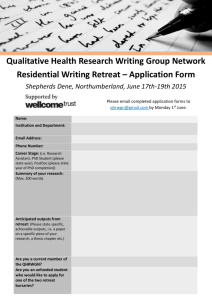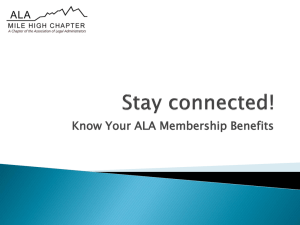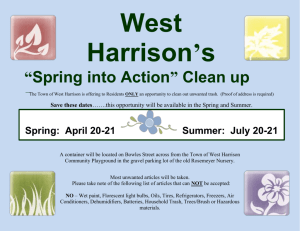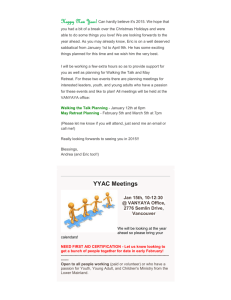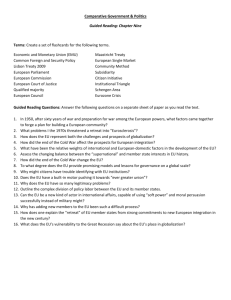AE Retreat Notes - National Council
advertisement
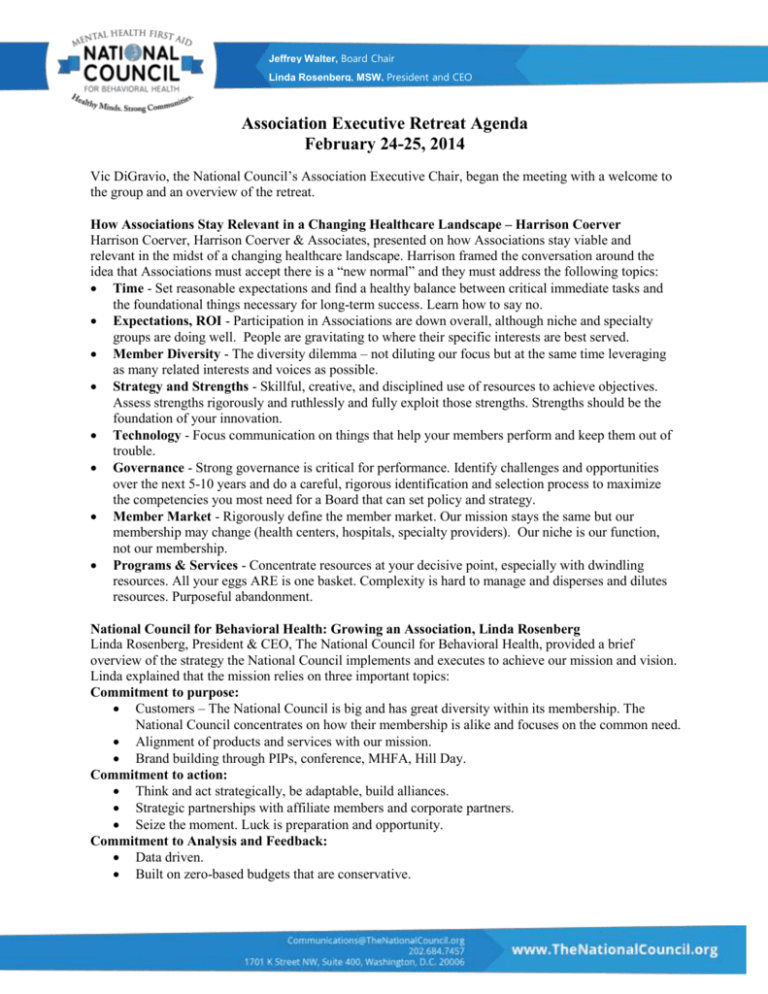
Jeffrey Walter, Board Chair Linda Rosenberg, MSW, President and CEO Association Executive Retreat Agenda February 24-25, 2014 Vic DiGravio, the National Council’s Association Executive Chair, began the meeting with a welcome to the group and an overview of the retreat. How Associations Stay Relevant in a Changing Healthcare Landscape – Harrison Coerver Harrison Coerver, Harrison Coerver & Associates, presented on how Associations stay viable and relevant in the midst of a changing healthcare landscape. Harrison framed the conversation around the idea that Associations must accept there is a “new normal” and they must address the following topics: Time - Set reasonable expectations and find a healthy balance between critical immediate tasks and the foundational things necessary for long-term success. Learn how to say no. Expectations, ROI - Participation in Associations are down overall, although niche and specialty groups are doing well. People are gravitating to where their specific interests are best served. Member Diversity - The diversity dilemma – not diluting our focus but at the same time leveraging as many related interests and voices as possible. Strategy and Strengths - Skillful, creative, and disciplined use of resources to achieve objectives. Assess strengths rigorously and ruthlessly and fully exploit those strengths. Strengths should be the foundation of your innovation. Technology - Focus communication on things that help your members perform and keep them out of trouble. Governance - Strong governance is critical for performance. Identify challenges and opportunities over the next 5-10 years and do a careful, rigorous identification and selection process to maximize the competencies you most need for a Board that can set policy and strategy. Member Market - Rigorously define the member market. Our mission stays the same but our membership may change (health centers, hospitals, specialty providers). Our niche is our function, not our membership. Programs & Services - Concentrate resources at your decisive point, especially with dwindling resources. All your eggs ARE is one basket. Complexity is hard to manage and disperses and dilutes resources. Purposeful abandonment. National Council for Behavioral Health: Growing an Association, Linda Rosenberg Linda Rosenberg, President & CEO, The National Council for Behavioral Health, provided a brief overview of the strategy the National Council implements and executes to achieve our mission and vision. Linda explained that the mission relies on three important topics: Commitment to purpose: Customers – The National Council is big and has great diversity within its membership. The National Council concentrates on how their membership is alike and focuses on the common need. Alignment of products and services with our mission. Brand building through PIPs, conference, MHFA, Hill Day. Commitment to action: Think and act strategically, be adaptable, build alliances. Strategic partnerships with affiliate members and corporate partners. Seize the moment. Luck is preparation and opportunity. Commitment to Analysis and Feedback: Data driven. Built on zero-based budgets that are conservative. Jeffrey Walter, Board Chair Linda Rosenberg, MSW, President and CEO Facilitated Discussion: Membership, Services & Programs This session was broken up by a number of questions that were posed by the facilitator or Association Executives. “As the marketplace changes resources are constricting. Provider’s resources are shrinking and they have to make the hard decision of whether they want to shell out money for dues, particularly as we also are competing against other associations. How do we prove our membership is valuable and necessary?” Harrison pointed out that members take our services for granted. We must make the intangible tangible. Maids fold the end of the toilet paper into a point to remind you that they were there and performed a service. You must be able to articulate what you are giving them in concrete ways relating to money or other tangible outcomes, “Because we did X for you, you got Y.” A number of Association Executives shared different tactics they use to achieve this goal, for example: Extrapolating what each member saved and projecting what they will save due to membership. Sending a survey to members around member satisfaction and perceived benefit. Producing an annual report. Creating a report card that rates you against your strategic plan. Harrison ended the conversation reminding AEs to connect these with what you save them economically “Are there innovative programs and services Associations are using to keep members engaged?” Transportation reimbursement/benefits. Workers comp and medical insurance trusts. Healthcare newsletters. Member based practice improvement collaborative that allows states to access integrated claims database with claims information, risk data and predictive modeling. “How do you deal with mergers and dues structures?” Grandfather plans in and slowly change dues over the course of 3 years. Share budget and formulas and allow members to understand and contribute to designing the new dues structure. Create a menu of services and allow for “al la carte” dues structure. Behavioral health regulations are cumbersome and create additional obstacles in integration. Engage with FQHCs in multiple ways, including combining key FQHC and CBHC data to support lobbying efforts that benefit both systems and identifying economic and other tangible benefits that FQHCs would have as our members/partners. Ohio and Pennsylvania provide good examples of successful mergers. Follow-up items – National Council to share sample Code of Ethics and an ideal template for MH/SU services covered by Medicaid. Facilitated Discussion: Workforce Everyone agreed there are significant workforce shortages. The group identified a number of contributing factors, including: Stringent licensing requirements. Low wages as the result of backing into set reimbursement rates. Poor loan forgiveness programs. Jeffrey Walter, Board Chair Linda Rosenberg, MSW, President and CEO Many psych majors but few go into graduate programs (very few men). The group explored a number of ideas to combat these challenges: Marketing efforts to attract workforce, especially current college students where the most popular major is psychology and millennials, a generation that research suggests is particularly interested in professions that contribute to the common good. Sit down with insurance companies and providers and re-design licensing requirements that allow for more types of credentialed and licensed clinical staff while also maintaining the necessary quality and competencies. Increase reimbursement rates by meeting with local Mental Health Authorities and demonstrating that providers are losing money annually (use 990s) due to staff turnover, shortages, and efforts to offer competitive salaries. Moving to a capitation or managed care system which would result in savings. Increase in evaluation around workforce development issues. Maximizing or creating positions (like an agency affiliated counselor) and ensuring they fit within state licensing plans. Improve loan forgiveness program. Pass legislation that evaluates the state of BH workforce (HB1023 in Texas). Follow-up items: National Council to share California’s 5 year plan to increase workforce. Facilitated Discussion: Technology The group discussed various forms of technology people are using to improve information dissemination and communication with members: Invest in good video conferencing systems and equipment (Logitec C-910). Make sure that video is adding value to the participant experience. CVent for individualized email blasts and registering people for conferences and trainings. Voter Voice. Use cloud based storage and services. Twitter for communicating with legislators and members. Be sure to build in technology costs into budget. Facilitated Discussion: Self-Care Strategies Have events like this retreat to spend time with peers in a relaxed setting. Be more reasonable with staff deadlines and redefine “immediate response time”. Learn how to say NO! Be strategic in the battles we choose. Understand what percent of members will be affected and then determine an appropriate course of action. Implement Rapid Cycle Change Plans. Facilitated Discussion: AE Retreat & Next Steps There was interest in having an annual opportunity (like the retreat) to meet with each other and talk through shared challenges without others present. Want a time to meet and walk away with concrete strategies for how to position us in the future. Extend the retreat to two days and have it feel more like a retreat (comfortable seating, less formal, more time for conversations). Flip the agenda for Board and Association Executives meetings so the Association Executives meet before the Public Policy Committee.
